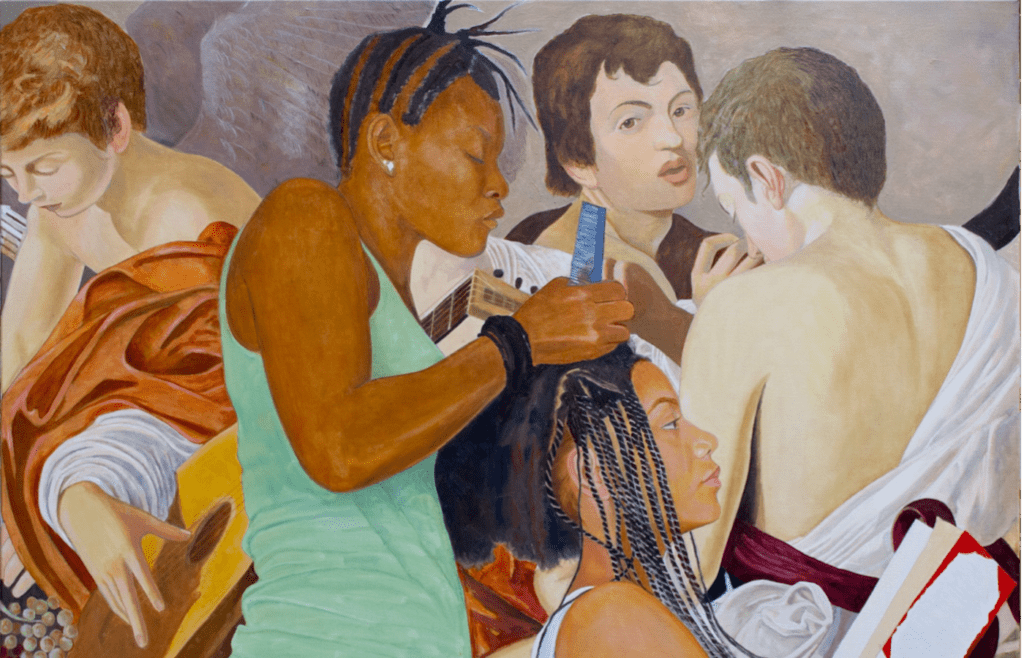Gallery 1957, Accra, Ghana
26 Oct 2024 - 11 Oct 2025

Arthur Timothy, Isabella & the Musicians (Caravaggio) (detail), 2024, Oil on canvas, 120 x 150 cm. Image courtesy of the artist and Gallery 1957.
Gallery 1957 proudly presents Keeping Time curated by Ekow Eshun and Karon Hepburn. The exhibition opens on the 26th of October in Accra. Keeping Time is a group exhibition which significantly brings together both international and Ghana-based artists from the African diaspora who explore notions of Blackness, being, and time.
By presenting artworks that are both dream-like and speculative, abstract and figurative, the exhibition questions and disrupts our sense of being in the world through African diasporic perceptions of time. The exhibition is presented as a sequel to Gallery 1957’s monumental 2023 group show, In and Out of Time curated by Ghanaian-British writer and curator Ekow Eshun, and is a highlight of Accra Cultural Week, taking place from the 24th – 28th October 2024: a series of interconnected, intimate and public events serving to encourage deeper engagement with Ghana’s vibrant contemporary art scene and spearheaded by Gallery 1957.
The show introduces artists who are exhibiting with Gallery 1957 for the first time, such as Okiki Akinfe, ruby onyinyechi amanze, Alvaro Barrington, Winston Branch, Kenwyn Crichlow, Kimathi Donkor, Ibrahim El-Salahi, Lyle Ashton Harris, Andrew Pierre Hart, Che Lovelace, Sola Olulode, Sikelela Owen, Ravelle Pillay, Elias Sime, Lina Iris Viktor and Michaela Yearwood-Dan, as well as returning artists Gideon Appah, Rita Mawuena Benissan, Amoako Boafo, Phoebe Boswell, Godfried Donkor, Modupeola Fadugba, Julianknxx, Arthur Timothy, and Alberta Whittle.
Perhaps it can be said of all artworks that they affect our perception of time. But in the case of an exhibition of Black artists that is taking place in Africa, context becomes a significant factor. This is to say that the exhibition proceeds from an awareness that the experience of time is often a reflection of power relations between societies. In the Western imagination, people of African descent have historically been seen as the antithesis of Western modernity. They have been considered savage where the West is civilised. Ignorant instead of rational. Underdeveloped rather than advanced. Under colonialism, the human-centred perceptions of time that were commonplace in Africa before European presence, were subsumed within Western structures of industrial time and order. Indeed, the subjugation of indigenous peoples and their knowledge systems was taken as a prerequisite for advancement into the future.
Against this backdrop of chronopolitics and colonial imposition, Keeping Time explores how the work of artists is inviting looser and more lyrical readings of time. Conceived as a follow-up to In and Out of Time, the 2023 Gallery 1957 exhibition curated by Ekow Eshun, which was founded on a similar scepticism to linear notions of progress and modernity, Keeping Time presents works that invoke African diasporic perceptions of time as the inspiration for works of expansive dreaming and possibility. Works conjured on the basis of what the scholar Geneva Smitherman defines as African People’s Time: ‘Being in tune with human events, nature, seasons, natural rhythms, not a slave to the artificial time of the man-made clock. Being “in time,” in tune with…the general flow of things [not] being on time.’
To keep time in music is to synchronise the work of the individual to the ensemble, all of the players in a group tied together to the same rhythm, the same tempo, the same sense of attunement. The act of keeping time in the context of this exhibition is imagined as a collective act of reaching beyond Western binaries of progress and underdevelopment.
To that end, the exhibition weaves together a lattice of conceptual and aesthetic considerations about the experience of time, from the intergenerational to the geographic and historical. It gathers works that range from abstraction to figuration, as created by a multigenerational span of artists, with the most senior figures, such as Winston Branch and Kenwyn Crichlow born in the 1940s and 1950s, and the youngest, including Sola Olulode, Rita Mawuena Benissan and Okiki Afinke, born in the 1990s. The exhibition also shows paintings by Caribbean-born artists, such as Branch, Crichlow, Che Lovelace and Alberta Whittle in West Africa for the first time, placing them in conversation with the work of British and Ghanaian-born artists in pursuit of a shared conjuring of Black diasporic cultural identity as ‘a state of being and a process of becoming, a condition and consciousness located in the shifting interstices of here and there, a voyage of negotiation between multiple spatial and social identities.’ (Paul Tiyambe Zeleza). And it presents artists such as Godfried Donkor, Arthur Timothy and Kimathi Donkor who are exploring the absence or marginalisation of the Black figure in Western art history, visiting the past in order to offer a reframing of presence and memory that situates Black people at the subjective centre, rather than the periphery, of historical narrative. The result is a set of individual works acting in rhythm and attunement in order to assert the richness and complexity of Black being and Black moving through the world.